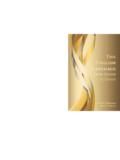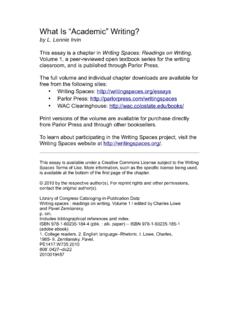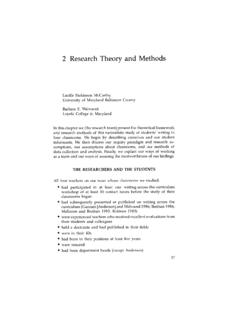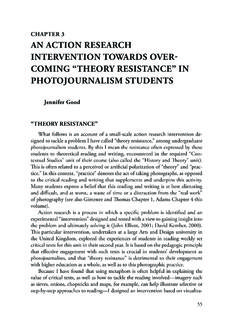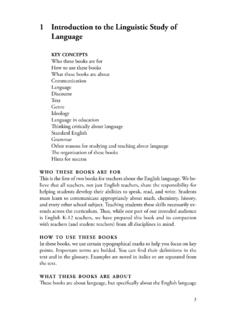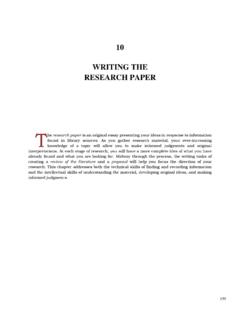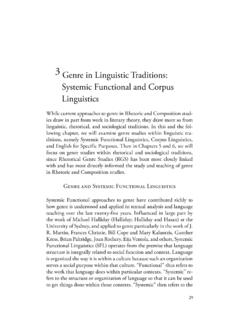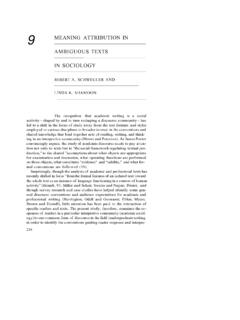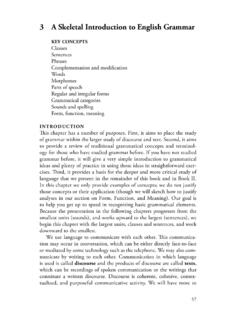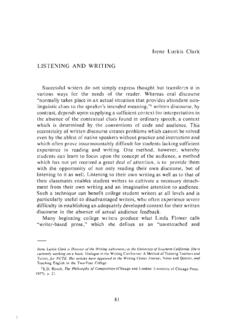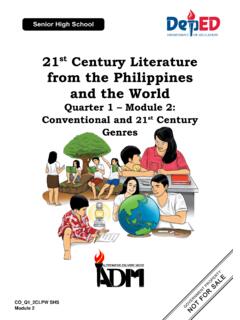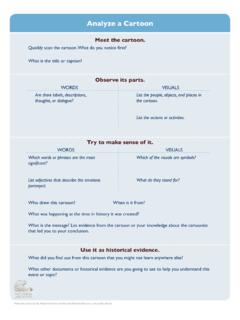Transcription of Looking for Trouble: Finding Your Way into a Writing ...
1 Looking for trouble : Finding YourWay into a Writing Assignmentby Catherine SaviniThis essay is a chapter in Writing Spaces: Readings on Writing , Volume 2, a peer-reviewed open textbook series for the Writing the full volume and individual chapters from: Writing Spaces: Parlor Press: WAC Clearinghouse: versions of the volume are available for purchase directly from Parlor Press and through other booksellers. This essay is available under a Creative Commons License subject to the Writing Spaces' Terms of Use. More information, such as the specific license being used, is available at the bottom of the first page of the chapter. 2011 by the respective author(s). For reprint rights and other permissions, contact the original author(s).Library of Congress Cataloging-in-Publication DataWriting spaces : readings on Writing .
2 Volume 1 / edited by Charles Lowe and Pavel bibliographical references and 978-1-60235-184-4 (pbk. : alk. paper) -- ISBN 978-1-60235-185-1 (adobe ebook)1. College readers. 2. English language--Rhetoric. I. Lowe, Charles, 1965- II. Zemliansky, 2010808 .0427--dc22201001948752 Looking for trouble : Finding Your Way into a Writing AssignmentCatherine SaviniThe main character in the movie Misery is a writer named Paul Shel-don, who after a serious car accident is res cued by his self- pro claimed number one fan, Annie Wilkes.* Annie holds him captive, withhold-ing pain medications and torturing him mentally and physically while demanding that he write a novel that brings her favorite character, Misery Chastaine, back to life. The movie trailer for Misery reads, Now Paul Sheldon must write as if his life depended on it.
3 Because it does. This is no one s ideal Writing scenario, nor is it a common one, but the direct association of Writing and suffering will not seem far-fetched to anyone who writes. Based on a Stephen King novella of the same name, Misery suggests that even a prolific writer like King, who has written screenplays, novels, short stories, and essays for the past thirty-five years, finds Writing difficult, even are, if you have ever written a paper, you ve experienced the uneasiness caused by the combination of a blank page and a loom-ing deadline. Though it may seem counterintuitive at the outset, one way to diminish the considerable difficulty of getting started on a new assignment is to look for something that troubles you, seek out diffi-culty, find problems. All academic disciplines seek to impart in their students the ability to identify, mull over, and sometimes solve chal-* This work is licensed under the Creative Commons Attribution-Noncommercial-ShareAlike United States License and is subject to the Writing Spaces Terms of Use.
4 To view a copy of this license, visit or send a letter to Creative Commons, 171 Second Street, Suite 300, San Francisco, California, 94105, USA. To view the Writing Spaces Terms of Use, visit Your Way into a Writing Assignment53lenging problems. Not surprisingly, the benefits of a willingness and mental acuity to greet complex problems extend well beyond the all deal with problems of varying complexity on a daily basis. If we are successful in dealing with life s challenges, it s likely that we follow a particular process for meeting these challenges, whether we are conscious of it or not. Here is an example of this process:Problem: My car broke that emerge from this problem: Can I fix it my-self? If not, where should I take it to get it fixed? Whom can I trust? Could I get a recommendation from someone?
5 In light of the estimate is it worth getting it fixed or should I turn it in to cash for clunkers and buy a new car? How will I get around while my car is in the shop?What is at stake?: If you don t pursue these questions and you take your car to the first dealer you see, you might choose a mechanic who is notorious for overcharging or for sloppy work. Or you might be without wheels for awhile and unable to get to work. Precious time and your hard-earned cash are at stake here. In order to make an informed decision, we must sit with a problem and weigh our are an expected part of life, and our ability to deal with them can help determine our personal and professional success. In fact, recent studies suggest that the ability to wrestle with problems is what makes a successful leader.
6 Successful leaders, according to Roger Martin, Dean of the Rotman School of Management at the Univer-sity of Toronto, have one thing in common: the power of integrative thinking. Martin borrows the words of F. Scott Fitzgerald, author of The Great Gatsby, to define integrative thinking as the ability to hold two opposing ideas in mind at the same time and still retain the ability to function. According to Fitzgerald, integrative thinking is a sign of first-rate intelligence ; according to Martin, who examined 50 successful managers for his book The Opposable Mind: How Successful Leaders Win Through Integrative Thinking, it is the sign of a successful leader. Integrative thinkers embrace complexity. They sit with prob-lems eschewing the easy answers. They tap into the tension between two opposing ideas to produce a third idea.
7 And, ultimately, they pro-Catherine Savini54duce new insights and develop new alternatives. This habit of mind can and should be cultivated (Martin 62).Problems as ProcessYou can cultivate and take advantage of this mode of thinking any time you have a paper to write. Let us return to the question of how one uses problems to begin a Writing assignment. Despite the fact that Writing assignments vary from class to class, discipline to discipline, and university to university, Looking for trouble can be an effective approach regardless of the assignment. In fact, sometimes Writing prompts or essay questions direct you toward trouble . Here is an ex-ample of one such prompt:Although Hegel differs from Rousseau in his hostility toward the notion of the noble savage and his rejection of origin sto-ries, both Hegel and Rousseau are keen to understand con-temporary civilization in light of historical processes.
8 What is it, then, that allows them to come to such different conclu-sions about the present, with Hegel suggesting that freedom is on the march and Rousseau arguing that freedom is in re-treat?1 This essay question does the work of problem Finding for the stu-dents. The instructor highlights the problem in the question by juxta-posing Rousseau s and Hegel s ideas and theoretical approaches. Most of you are probably familiar with the compare and contrast paper; this assignment essentially asks students to compare and contrast Rousseau and Hegel. By identifying a specific problem and posing a question, this instructor helps students avoid a common pitfall of the unsuccess-ful compare and contrast essay. Unsuccessful compare and contrast essays simply catalogue similarities and differences without developing an argument.
9 While it is possible that your high school teacher did not expect you to develop an argument in a compare and contrast essay, your college professor expects you to do so, whether or not the assign-ment explicitly says it will be your responsibility to locate a problem. Here is an example of an assignment that specifically asks students to find a problem: Finding Your Way into a Writing Assignment55 Identify and examine a human rights topic about which you would like to know more. You are welcome to consult with the instructors and TAs for ideas. You should use Internet, library, and other sources to gather information on this topic; this is not a full-scale research paper, so you need to find a small number of adequately comprehensive sources. Your essay should (1) identify the issue; (2) describe its scope and frequency in geographic, regime-type, temporal, socio-demo-graphic, or other terms, as appropriate; (3) identify the sense in which it is a human rights violation (of what article of what covenant, or with respect to what norm); (4) tell us what you have been able to learn about its causes, and (5) identify po-litical, social, cultural, economic or other factors that appear to contribute to its increase or decrease.
10 You should critically assess biases or shortcomings in the information sources you used to research your the prompt does not specifically use the term problem, it is clear that students are meant to focus on human rights issues or violations rather than successes in the area of human rights. In other words, these students have been sent out to look for trouble related to human rights. Other Writing assignments will not even hint at prob-lems. For example:Food plays a significant role in Edith Wharton s Age of In-nocence. For this paper you should construct a persuasive ar-gument in which you consider how the depictions of food and the rituals surrounding it reflect and promote the larger themes of the novel. Consider the following questions: Who is depicted eating and why? What do they eat and how?
